BMW produces 8 different series with various models in each of them. Currently, the series range from BMW 1 Series to 8 Series. The specific numbers mean different things. The even number series are 2-door cars and the odd are 4-door sedans.
The higher the number of the series, the more costly the vehicle will be. The BMW 1 Series is the cheapest and the 8 Series is the most luxurious and expensive.
All odd BMW Series (1, 3, 5 and 7) are a combination of 4-door models and luxury sedans, some of which are also available in convertible versions. The 3, 5 and 7 Series BMWs are designed to be luxury executive vehicles. The even number BMW series (2, 4, and 6) are sportier designed 2-door coupes.
Odd BMW Series specifics
Overall, odd BMW Series are grand tourers, subcompact and compact executive cars. Most of them started as 2-door models with gasoline engines and later on evolved into gran coupes with diesel and gasoline options available.
The BMW 1 Series
Originally, the BMW 1 Series was created as a 3-door hatchback that was very comfortable and efficient to drive in city traffic. That was the BMW E81 model. Later on, other models like the E87 5-door hatchback and the BMW E88 convertible 1 Series came out. What unites all BMW 1 Series cars is the fact that they are very compact.
All 1 Series vehicles are rear-wheel drive, whereas most cars in the small-hatchback segment use front-wheel power. These are also available as both gasoline and diesel engines.
The BMW 3 Series
The BMW 3 Series is the most compact executive sedan car by BMW. The model range of the BMW 3 Series is quite large and includes a 2-door convertible and coupe, 4-door sedan, and even 5-door liftback. The 3 Series is BMW’s best-selling model and makes up more than 30% of its sales.
There have been seven generations of 3 Series so far, dating back as far as 1975 with the E21. These amazing luxury sedans became BMW’s best-seller for a reason. They are as good as the more expensive 5 and 7 Series, with the major difference being their smaller size and more affordable price.
The BMW 5 Series
The BMW 5 Series is the successor of the BMW New Class sedan which was manufactured in 1962. The 5 Series was born in 1972 and remains to this day, one of the best executive vehicles produced by BMW. Engine options are both diesel and gasoline. The 5 Series engines are four-cylinder, six-cylinder, V8, and V10, which are either turbocharged or naturally aspirated.
The BMW 5 Series is the second best-selling BMW series after the BMW 3 Series. It is the middle ground between the larger 7 Series and the smaller 3 Series of luxury sedans.
The BMW 7 Series
The BMW 7 Series is the largest BMW luxury executive sedan that the brand produces. Of course, it is also the most luxurious and expensive. The full-size luxury sedan is BMW’s flagship and its body style is limited to a sedan. All the innovations that BMW introduces first appear in the BMW 7 Series and later on are trickled down to other series and models.
Originally the BMW 7 Series were powered by gasoline inline-4, V8, and V12 engines. Since 1995, diesel options have been available as well. Both 3 Series and 5 Series have a sporty M3 and M5 vehicle, but the BMW 7 Series doesn’t have a sports version.
Even BMW Series specifics
This brings us to the sporty 2-door even numbered series.
The BMW 2 Series
BMW 2 Series serve a segment of subcompact executive cars or the so-called C-segment. These are rear-wheel-drive powered vehicles, available in a coupe and convertible bodies. The 2-door vehicles are quick, compact, and very maneuverable, making them the perfect choice for a sole driver or a couple.
The BMW 4 Series
The BMW 4 Series is a range of models manufactured as compact executive cars. They are based on the 2-door models of BMW 3 Series. The Series is available in 2-door coupe, convertible and as a 4-door fastback coupe, also known as the Gran Coupe.
The first 4 Series was produced in 2013. They are available in 4 and 6 cylinders for diesel and in 4, 6 and 3 cylinders for gasoline engines.
The BMW 6 Series
The 6 Series came out as grand tourer cars and has remained as such since 1976. Designed for high-speed and long road trips, this is a great choice for a traveling business person.
Naturally, as an even series, the BMW 6 Series is an ancestor of a 2-door car. However, it has grown over the years. It started as a two-door coupe, but later on in the 2000s, convertibles also became available. Nowadays there are even four-door coupe body styles, which started in 2012.
The BMW 8 Series
The 8 Series started in the mid-1980s with a two-door coupe and has remained as such. The series is a range of models of grand tourer coupes and convertibles. This is a rear-wheel-drive vehicle also available in xDrive (all-wheel). It first started as a performance upgrade to the 6 Series with a higher price.
Comparing BMW series
Which are the cheapest BMW Series to buy and maintain?
The cheapest BMW models are the smallest ones, namely, the 1 Series and 2 Series. They are the least expensive models to drive and own. The 1 Series is a hatchback, suitable for city driving, whereas the 2 Series serves the C-segment and is quite comfortable to drive, while still bringing the driving pleasure of a sports car.
Is a BMW 3 Series or 5 Series better?
The BMW 3 Series is slightly smaller and a lot less expensive than the 5 Series. Speaking from a standalone point of car evaluation without considering the price, the Series 5 is larger and brings in extra quality. The 3 Series is BMW’s best-selling series for a few reasons. It brings almost everything the Series 5 does, at a discounted price.


